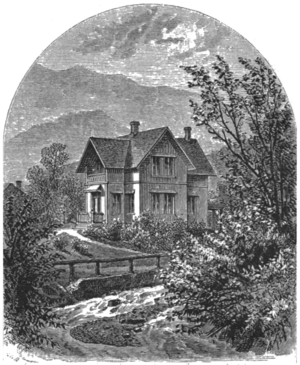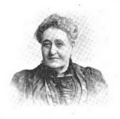Sara Jane Lippincott facts for kids
Quick facts for kids
Sara Jane Lippincott
|
|
|---|---|

Sara Jane Lippincott ("Grace Greenwood"), circa 1850
|
|
| Born | Sara Jane Clarke September 23, 1823 Pompey, New York, U.S. |
| Died | April 20, 1904 (aged 80) New Rochelle New York |
| Resting place | Grove Cemetery, New Brighton, Pennsylvania, U.S. |
| Pen name | Grace Greenwood |
| Occupation |
|
| Language | English |
| Nationality | American |
| Education | Greenwood Institute |
| Genre | journalism, fiction, poetry, children's literature |
| Subject | women's rights, abolition |
| Spouse |
Leander K. Lippincott
(m. 1853) |
| Children | Annie Grace Lippincott |
| Relatives | Jonathan Edwards |
| Signature | |
Sara Jane Lippincott (who used the pen name Grace Greenwood) was an American writer, poet, and journalist. She was born on September 23, 1823, and passed away on April 20, 1904. She was one of the first women allowed to report from the Congressional press areas. There, she used her questions to speak up for social change and women's rights.
Sara Jane Lippincott wrote many books, especially for young readers. Some of her most famous children's books include History of My Pets (1850), Recollections of My Childhood (1851), and Stories of Many Lands (1866). She also wrote for grown-ups, including travel books and poetry. She worked as an editor and writer for many American magazines and newspapers. She even wrote for journals in London, England. For several years, she lived in Europe to improve her health and for her daughter's schooling. Later, she lived in Washington D.C. and New York.
She was a well-known person in the writing community of New York. She knew many famous writers like Edgar Allan Poe, Margaret Fuller, and Ralph Waldo Emerson.
Contents
Early Life and Learning
Sara Jane Clarke was born on September 23, 1823, in Pompey, New York. Her parents were Deborah Baker Clarke and Dr. Thaddeus C. Clarke. Her family was related to the famous Princeton President Jonathan Edwards.
Sara was a brave child. When she was ten, she rode a horse standing up without a saddle! At age twelve, she went to school in Rochester, New York, living with her older brother. Her education was not unusual, but she loved literature. She studied Italian, algebra, and history. It soon became clear that writing was what she was meant to do. By age sixteen, she was already writing "fresh, lively" pieces for local newspapers in Rochester.
Moving to New Brighton
In 1842, Sara and her family moved to New Brighton, Pennsylvania. Her father worked there as a doctor. Sara always thought of New Brighton as her home. She attended the Greenwood Institute, a school for young ladies, in New Brighton. She may have chosen her pen name, Grace Greenwood, from this school. She finished school when she was nineteen.
Her Writing Career Begins
Soon after returning home, in 1845 and 1846, Sara began writing under her famous pen name, Grace Greenwood.
Becoming a Poet and Writer
At first, Sara Jane Lippincott wrote poems and stories for children. She published these in local newspapers. In 1844, when she was 21, she became nationally known. This happened when a poem of hers was published in the New York Mirror. Soon after, she wrote for other popular magazines like the Home Journal. She used both her real name and her pen name. By 1849, she was an assistant editor for Godey's Lady's Book. She also edited Godey's Dollar Newspaper.
For several years, she spent her summers in New Brighton. In winter, she was in Philadelphia, Washington, D.C., or New York City. She wrote for many different publications.
A Voice for Change
Lippincott was the first woman reporter in Washington, D.C. She started writing letters for a Philadelphia newspaper in 1850. Many of her early writings were collected and published as Greenwood Leaves. She also became a reporter for the Saturday Evening Post. She was a respected journalist who often spoke up for women's roles and rights.
She joined The National Era, a weekly newspaper that was against slavery. She helped edit Harriet Beecher Stowe's famous book Uncle Tom's Cabin when it was first published in parts. Lippincott also wrote her own articles and travel letters for the paper. Her strong anti-slavery views added to the national debate at the time.
Traveling and Reporting
Lippincott's poetry was also very popular. Her book Poems (1851) included passionate poems. In the same year, she published History of My Pets. Sophia Hawthorne, the wife of author Nathaniel Hawthorne, said it was "the best children's book he has ever seen."
In 1853, she visited Europe for the first time. She was on assignment for The New York Times, making her the first woman reporter on their payroll. She stayed abroad for over a year. She called this time "the golden year of her life." Her travel stories were very popular. These stories were collected and published as Haps and Mishaps of a Tour in Europe. When she returned, she also traveled often to California, writing vivid descriptions of the land. In 1855, she published Merrie England, the first of her travel books for children.
Starting a Children's Magazine
On October 17, 1853, Sara married Leander K. Lippincott in Philadelphia. He was also a reporter. That same year, Sara and her husband started The Little Pilgrim. This was a monthly magazine for American children. It aimed to entertain, teach, and help children. Sara wrote many articles and essays for the magazine, sharing historical and biographical information. It was in this magazine that Louisa May Alcott first published her children's stories. Over time, many of Sara's writings from the magazine were collected into nearly a dozen books for young readers. These books were known for how well they taught history.
On October 3, 1855, Sara and Leander had a daughter named Annie Grace. In 1856, a book called A Forest Tragedy, and other Tales was published. In 1857, Stories and Legends of History and Travel came out, which was the second book in her travel series for children.
Speaking Up for Rights
Sara Jane Lippincott was also a great speaker. She gave many lectures before and during the American Civil War. She spoke about her strong beliefs against slavery and other social issues. These included improving prisons and mental hospitals, and ending the death penalty. During the war, she lectured to soldiers and at special events called sanitary fairs. President Abraham Lincoln even called her "Grace Greenwood the Patriot."
After the war, women's rights became the main focus of her speeches. Her writings from this time were published in Records of Five Years (1867). By the 1870s, Lippincott wrote mostly for the New York Times. Her articles mainly focused on women's issues. For example, she argued for Fanny Kemble's right to wear pants. She also supported Susan B. Anthony's right to vote and all women's right to get equal pay for equal work.
Life in London and Washington

After her husband left the United States in 1876, Sara Jane Lippincott continued her writing and lecturing. She needed to support herself and her daughter. Her daughter trained to become an actress.
By 1879, Lippincott was living in London with her daughter. For the ten years before this, she had done most of her important work in journalism. She wrote articles from Washington for the New York Tribune and the New York Times. These articles were about national and political topics. She showed a great understanding of political history and how the two main political parties in the United States worked. She also wrote several series of letters from Europe, mainly from London, for the New York Times and a leading California newspaper. She worked for the London Journal and wrote a biography called Queen Victoria: Her Girlhood and Womanhood (1883). In 1887, she returned to the United States and kept working.
In 1895, she was living on Capitol Hill with her daughter. She was working on a piece called "Recollections of Washington." Even though she loved Washington, D.C., her health was better when she was in Europe.
Later Years and Legacy
Lippincott later lived with her daughter in New Rochelle, New York. She passed away there from bronchitis on April 20, 1904. Sara Jane Lippincott is buried in the Civil War section of Grove Cemetery in New Brighton. Her obituary (a notice of her death) was on the front page of the New York Times. This shows how important she was as a writer in the 1800s.
Her writing style was very new and exciting for her time. People described it as "brilliant, lively, and charming." Her words seemed to jump off the page. Her writing had a special charm that was common in the best American works of the mid-1800s. She was a letter-writer who delighted many readers with her spirited and engaging style.
Her Books
- Greenwood Leaves (1850)
- History of my Pets (1851)
- Poems (1851)
- Recollections of my Childhood, and other stories (1852)
- Haps and Mishaps of a Tour in Europe (1854)
- Merrie England (1855)
- Forest Tragedy, and other tales (1856)
- Stories and Legends of Travel and History (1857)
- Stories from Famous Ballads (1860)
- Bonnie Scotland (1861)
- Records of Five Years (1867)
- Stories and Sights of France and Italy (1867)
- Stories of Many Lands (1867)
- Eminent Women of the Age: being narratives of the lives and deeds of the most prominent women of the present generation (1868)
- Summer Etchings in Colorado (1873)
- New Life in New Lands (1873)
- Heads and Tails: studies and stories of pets (1875)
- Emma Abbott, prima donna (1878)
- Queen Victoria, her girlhood and womanhood (1883)
- Stories for Home-folks, young and old (1884)
- Stories and Sketches (1892) (with Rossiter W. Raymond)
- Treasures from Fairyland (1879)
Images for kids


